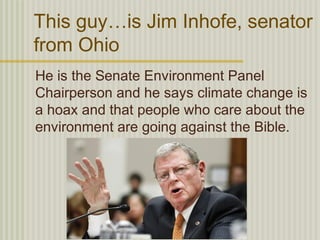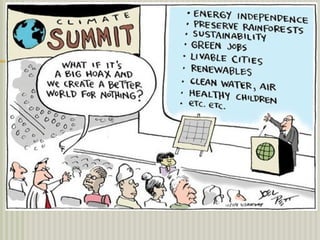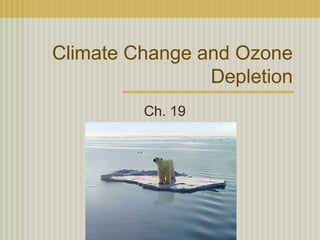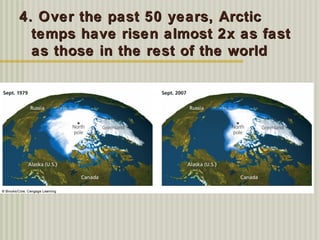AP Environmental Science Ch. 19, part 1 Miller LITE
- 1. This guy…is Jim Inhofe, senator from Ohio He is the Senate Environment Panel Chairperson and he says climate change is a hoax and that people who care about the environment are going against the Bible.
- 5. Climate Change and Ozone Depletion Ch. 19
- 6. What do I need to know about climate change? 1. What evidence do we have? (that’s today) 2. What are some of the potential and realized consequences of a changing climate? (that’s tomorrow) 3. What are the challenges to addressing climate change? (why is it so hard?) 4. What are some of the ways we can combat climate change (i.e. halt it and/or reverse it) 5. What have we already done? Did it work?
- 8. Studying volcanoes helps us understand climate change June 1991: Mount Pinatubo (Philippines) exploded Airborne pollutants, deaths, and damage Affected climate temperature - cooled the air for 15 mo. Like a test for scientists Climate predictions based on the forecasts of James Hansen of NASA and many others- were the models accurate? YES
- 14. Big Idea #1 The overwhelming scientific consensus is that the earth’s atmosphere is warming rapidly, mostly because of human activities, and that this will lead to significant climate change during this century.
- 15. Temperature and Climate Change are not new Volcanic emissions Solar storms Continental drift Meteors Glacial (ice ages) and interglacial periods It’s been pretty stable for the last 10,000 years
- 16. How do we know what the climate was like in the past? 1. Air bubbles in ice cores 2. Radioisotopes in rocks and fossils 3. Plankton in ocean sediments 4. Tree rings 5. Pollen in lake bottoms http://scied.ucar.edu/ice-cores-studying-p
- 17. Ice ages (glacials) Geologic records and atmospheric measurements show: Over the last 900,000 years there has been a steady cycle of glaciations (ice ages) that last about 90,000 years and interglacials that last about 10,000 years • We’re overdue for an ice age ;)
- 19. The greenhouse effect Good! :) Warms the earth by trapping some of the heat radiating off the surface of the earth The work of certain gasses in the atmosphere CO2, CH4, H20, N2O
- 20. Climate Change and Human Activities Humans have added more greenhouse gases to the atm. by Burning fossil fuels <-- most Farming/Ag (clearing forests/grasslands, cows CH4) Use of inorganic fertilizers (rice mostly, adds N2O) Burning forests Greenhouse gas levels are the highest since 160,000
- 21. It IS getting warmer Is it because of human activities? Evidence says yes Intergovernmental Panel on Climate Change (IPCC) Formed in 1988 to evaluate climate Use several levels of certainty • Virtually certain (more than 99% probability) • Very likely (90-99% probability) • Likely (66-90% probability)
- 22. Who is the IPCC? More than 2,500 climate experts from more than 130 countries Collect data from more than 29,000 experiments and trials Found that it is virtually certain that the troposphere is getting warmer due to human activities In 2007 shared the Nobel Peace Prize with Al Gore for alerting the world to the dangers of global warming
- 24. Quick Think How would you explain to someone how we know what the climate was like 100,000 years ago?
- 25. So what is the evidence? 8 key findings: 1. The 20th century was the hottest century of the past 1000 years
- 26. 2. Averaged over all land and ocean surfaces, temperatures warmed roughly 0.85ºC from 1880 to 2012, most of that since 1980
- 27. 3. The 10 hottest years since 1861 have been after 1990
- 28. 4. Over the past 50 years, Arctic4. Over the past 50 years, Arctic temps have risen almost 2x as fasttemps have risen almost 2x as fast as those in the rest of the worldas those in the rest of the world
- 29. 5. Glaciers and floating sea ice in some parts of the world are melting and shrinking at increasing rates Melting of Alaska’s Muir Glacier between 1948 and 2004 and 2004
- 30. 6. Warmer temps in Alaska and6. Warmer temps in Alaska and Russia are melting the permafrost,Russia are melting the permafrost, releasing more greenhouse gasesreleasing more greenhouse gases into the atmosphereinto the atmosphere
- 31. 7.the world’s average sea level rose by 10-20 cm (4-8 inches)
- 32. 8. Atmospheric CO2 levels have steadily increased with temperature
Editor's Notes
- High school to army to University of Tulsa BA in economics to politician.

































